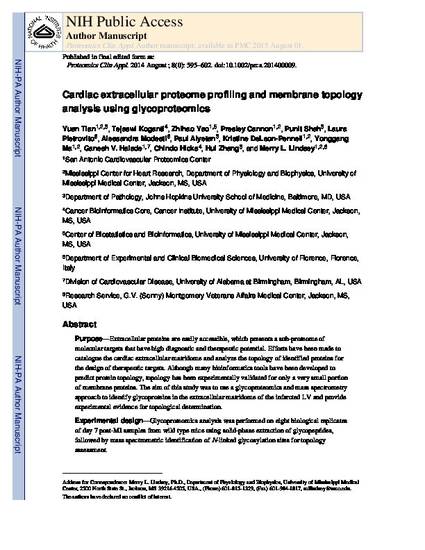
- Extracellular matridome,
- Glycoprotein,
- Left ventricle,
- Matrix metalloproteinase,
- Membrane orientation,
- Myocardial infarction
Purpose: Extracellular proteins are easily accessible, which presents a subproteome of molecular targets that have high diagnostic and therapeutic potential. Efforts have been made to catalog the cardiac extracellular matridome and analyze the topology of identified proteins for the design of therapeutic targets. Although many bioinformatics tools have been developed to predict protein topology, topology has been experimentally validated for only a very small portion of membrane proteins. The aim of this study was to use a glycoproteomics and MS approach to identify glycoproteins in the extracellular matridome of the infarcted left ventricle (LV) and provide experimental evidence for topological determination. Experimental design: Glycoproteomics analysis was performed on eight biological replicates of LV samples from wild-type mice at 7 days following myocardial infarction using SPE of glycopeptides, followed by mass spectrometric identification of N-linked glycosylation sites for topology assessment. Results: We identified hundreds of glycoproteins, and the identified N-glycosylation sites provide novel information on the correct topology for membrane proteins present in the infarct setting. Conclusions and clinical relevance: Our data provide the foundation for future studies of the LV infarct extracellular matridome, which may facilitate the discovery of drug targets and biomarkers.
Proteomics - Clinical Applications, v. 8, issue 7-8, p. 595-602
This is the peer reviewed version of the following article: Tian, Y., Koganti, T., Yao, Z., Cannon, P., Shah, P., Pietrovito, L., Modesti, A., Aiyetan, P., DeLeon‐Pennell, K., Ma, Y., Halade, G.V., Hicks, C., Zhang, H. and Lindsey, M.L. (2014), Cardiac extracellular proteome profiling and membrane topology analysis using glycoproteomics. Prot. Clin. Appl., 8: 595-602., which has been published in final form at 10.1002/prca.201400009. This article may be used for non-commercial purposes in accordance with Wiley Terms and Conditions for Use of Self-Archived Versions.
Available at: http://works.bepress.com/ganesh-halade/22/